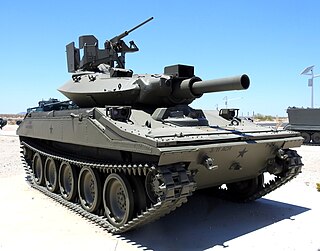
The M551 "Sheridan" AR/AAV was a light tank developed by the United States and named after General Philip Sheridan, of American Civil War fame. It was designed to be landed by parachute and to swim across rivers. It was armed with the technically advanced but troublesome M81/M81 Modified/M81E1 152 mm gun/launcher, which fired both conventional ammunition and the MGM-51 Shillelagh guided anti-tank missile.

The M26 Pershing was a heavy tank/medium tank of the United States Army. It was used in the last months of World War II during the Invasion of Germany and extensively during the Korean War. The tank was named after General of the Armies John J. Pershing, who led the American Expeditionary Force in Europe in World War I.

The MBT-70 was an American–West German joint project to develop a new main battle tank during the 1960s.

The M48 Patton is an American first-generation main battle tank (MBT) introduced in February 1952, being designated as the 90mm Gun Tank: M48. It was designed as a replacement for the M26 Pershing, M4 Sherman, M46 and M47 Patton tanks, and was the main battle tank of the U.S. Army and U.S. Marine Corps in the Vietnam War. Nearly 12,000 M48s were built, mainly by Chrysler and American Locomotive Company, from 1952 to 1961. The M48 Patton was the first U.S. medium gun tank with a four man crew, which replaced the traditional 5 crewmen tanks, a centerline driver's compartment, and no bow machine gun. As with nearly all new armored vehicles it had a wide variety of suspension systems, cupola styles, power packs, fenders and other details among individual tanks.

The M47 Patton was an American main battle tank, a development of the M46 Patton mounting an updated turret, and was in turn further developed as the M48 Patton. It was the second American tank to be named after General George S. Patton, commander of the U.S. Third Army during World War II and one of the earliest American advocates of tanks in battle.

The M60 is an American second-generation main battle tank (MBT). It was officially standardized as the Tank, Combat, Full Tracked: 105-mm Gun, M60 in March 1959. Although developed from the M48 Patton, the M60 tank series was never officially christened as a Patton tank. The US Army considered it a "product-improved descendant" of the Patton tank's design. The design similarities are evident comparing the original version of the M60 and the M48A2. It has been sometimes informally grouped as a member of the Patton tank family. The United States fully committed to the MBT doctrine in 1963, when the Marine Corps retired the last (M103) heavy tank battalion. The M60 tank series became America's primary main battle tank during the Cold War, reaching a production total of 15,000 M60s. Hull production ended in 1983, but 5,400 older models were converted to the M60A3 variant ending in 1990.

The Royal Ordnance L7, officially designated Gun, 105 mm, Tank, L7, is the basic model of the United Kingdom's most successful tank gun. It is a 105 mm L/52 rifled design by the Royal Ordnance Factories, intended for use in armoured fighting vehicles, replacing the older QF 20-pounder (84 mm) gun mounted on the British Centurion tank. The successful L7 gun has been fitted on many armoured vehicles, including the Centurion, the German Leopard 1 and several variants of the US M48 Patton and M60.

The T28 Super Heavy Tank was an American heavily armored tank/self-propelled gun designed for the United States Army during World War II. It was originally designed to break through German defenses of the Siegfried Line, and was later considered as a possible participant in the planned invasion of the Japanese mainland.
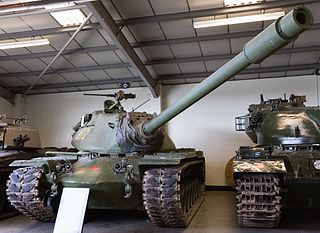
The M103 Heavy Tank was a heavy tank that served in the United States Army and the United States Marine Corps during the Cold War. Introduced in 1957, it served through 1974, by which time evolution of the concept of a main battle tank considered heavy tanks obsolete.

The T95 was an American prototype medium tank developed from 1955 to 1959. These tanks used many advanced or unusual features, such as siliceous-cored armor, new transmissions, and OPTAR fire-control systems. The OPTAR incorporated an electro-optical rangefinder and was mounted on the right side of the turret, and was used in conjunction with the APFSDS-firing 90 mm T208 smoothbore gun, which had a rigid mount without a recoil system. In addition, although the tanks were designed with a torsion beam suspension, a hydropneumatic suspension was fitted, and one of the tanks was fitted with a Solar Saturn gas turbine for demonstration purposes.
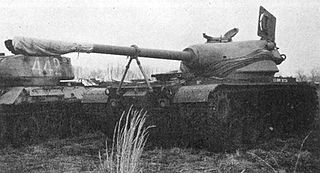
The T54 was a series of prototype American tanks of the 1950s with three different turrets, all armed with a 105 mm gun, mounted on the M48 Patton chassis. The T54 had a conventional turret with an autoloader with 3 shells, the T54E1 had an oscillating design with an autoloader, and the T54E2 had a conventional turret with a human loader.
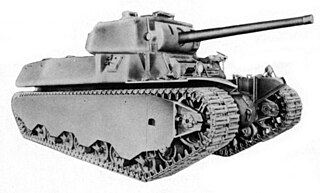
The Heavy Tank M6 was an American heavy tank designed during World War II. The tank was produced in small numbers and never saw combat.

The M46 Patton is an American medium tank designed to replace the M26 Pershing and M4 Sherman. It was one of the U.S Army's principal medium tanks of the early Cold War, with models in service from 1949 until the mid-1950s. It was not widely used by U.S. Cold War allies, being exported only to Belgium, and only in small numbers to train crews on the upcoming M47 Patton.
Tank development both evolved considerably from World War II and played a key role during the Cold War (1945–1990). The period pitted the nations of the Eastern Bloc and the North Atlantic Treaty Organization (NATO against each other.

A super-heavy tank or super heavy tank is any tank that is notably beyond the standard of the class heavy tank in either size or weight relative to contemporary vehicles.

The United States has produced tanks since their inception in World War I, up until the present day. While there were several American experiments in tank design, the first American tanks to see service were copies of French light tanks and a joint heavy tank design with the United Kingdom.

A main battle tank (MBT), also known as a battle tank or universal tank, is a tank that fills the role of armor-protected direct fire and maneuver in many modern armies. Cold War-era development of more powerful engines, better suspension systems and lighter composite armor allowed for the design of a tank that had the firepower of a super-heavy tank, the armor protection of a heavy tank, and the mobility of a light tank, in a package with the weight of a medium tank. Through the 1960s and 1970s, the MBT replaced almost all other types of tanks, leaving only some specialist roles to be filled by lighter designs or other types of armored fighting vehicles.
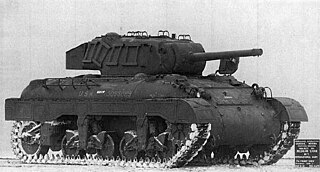
The Medium Tank M7, initially Light Tank T7, was an American tank, originally conceived as an up-gunned replacement for the Light Tank M3/M5 ("Stuart"). The project developed to mount the same 75mm armament as the M4 Sherman while retaining the light weight and maneuverability of the M3 Stuart; however, during development the weight of the prototype surpassed the US Army's standard for light tanks and crossed into the medium tank category and was renamed. The M7 had significantly less armor than the M4 Sherman, no greater firepower, and held only a slight advantage in top speed. For these reasons, and because the M4 was already battle-tested and in full production, the M7 was cancelled in 1943.

The T30 Howitzer Motor Carriage (HMC) was a United States Army self-propelled gun used in World War II. Its design was based on requirements for an assault gun issued by the Armored Force in 1941 and it was built as an interim solution until a fully tracked design was complete.

The M68 is an American 105 mm tank gun. It uses a British-designed L7 gun tube and cartridges with an American-designed mount, breech assembly and recoil mechanism.



















